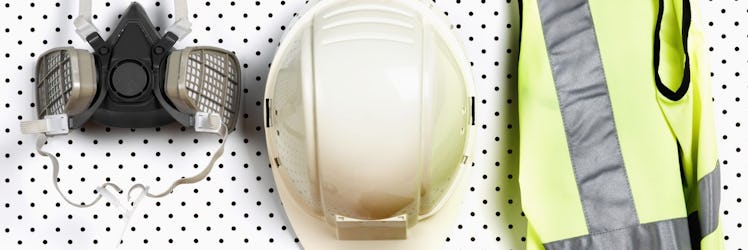A Baby-Proofing Checklist For All The Most Dangerous Rooms In Your House
The toilet may be your safe haven but that doesn't make it safe.

Your baby-proofing checklist shouldn’t consist merely of duct tape and bubble wrap, even though they’re crazy affordable and easy to install on both furniture and your kid (don’t do that), and theoretically fix everything. The Consumer Product Safety Commission (CPSC), which keeps close tabs on kids’ home safety, would prefer you do something reasonable, like install a pool gate lock or a furniture harness. If you can’t picture what that last thing is, good news, there’s someone whose job it is to know!
The International Association For Child Safety (IAFCS) certifies professional child-proofers — experts trained to ensure your home is safe for your kid, not kids trained to turn your emails into gibberish nonsense. They’re definitely not cheap – expect to pay a $100 for an assessment followed by many hundreds more for labor and products – but they will give you the peace of mind of a proper install and CPSC-approved products.
If you don’t have the extra scratch, or are a seasoned DIYer, you can certainly do the baby-proofing yourself. Just make sure you do due diligence on the child-proofing products you buy because they have a tendency to get recalled. Also, make sure you have plenty of patience (beer) and can follow installation instructions to the letter (so maybe forget the beer). These are, after all, devices meant to keep your child from harm or death.
Where To Start
You probably know to keep the knives in the kitchen well out of reach, and that cleaning supplies and other chemicals should be locked up. But there are other less obvious places you’ll want to install your safety arsenal. Also, maybe start by ditching, or at least locking up, your actual arsenal.
The Kitchen
This isn’t just about knives. It’s also a tale of appliances and fire, which sounds like the least popular George R. R. Martin novel ever. Small appliances should be stored away from the edge of counters to keep them from being pulled down. Pot and pan handles should be turned inward on the stove for the same reason.
Safety Apparatus You’ll Need:
- Locks for cabinets and drawers that contain knives or cleaning supplies
- Stove guards that keep reaching hands at bay
Stairwells
Even if you’re crazy diligent, your kid will likely topple off a stair or 2. Hell, you will probably topple off a stair or 2. But instead of replacing every stair in your home with an elaborate block and tackle system (as in boats, not NFL), baby gates are the way to go. Make sure you use the kind that are held in place by more than just pressure; those are easily bullied into breaking.
Safety Apparatus You’ll Need:
- Sturdy, non-pressure or non-friction install gates that anchors to the wall
- Adequate lighting — motion-activated a plus!
The Garage
It’s totally reasonable that you want to teach your kid how to bro down in the garage, but they’re more apt to pour oil into their mouth than the car. If your kid is going to be around the tools and heavy stuff, make sure it’s stowed safely and not easily pulled down from high shelves. If your garage is a disaster, consider installing a high door lock to simply keep them out. That goes for almost any place that isn’t or can’t be baby-proofed.
Safety Apparatus You’ll Need:
- Cabinet locks
- Lockable storage
- Door lock that allows you to exit and enter while keeping the kid out
- New, high-end steel toolbox (Not at all for safety, your kit is just whack)
The Bathroom
The bathroom can be a super dangerous place for a kid, and not just when they stumble in while you’re getting some reading done. Fact is, this is actually one of the most dangerous rooms in your house — nearly 70 percent of all accidents occur here, and again, not those kind of accidents — with abundant hazards from outlets, cabinets, and standing water. Even the toilet has been known to cause drowning.
Safety Apparatus You’ll Need:
- Toilet latch
- Outlet covers
- Locks for cabinets containing cosmetics, medicine, or other potentially harmful products
Living Room
So many objects in the living room are soft and inviting – the couch, the armchair, your belly – but therein lies a hidden danger. All those things are heavy (that’s right, all of them), and climbing kids topple TVs and bookshelves at a frighteningly high rate.
Safety Apparatus You’ll Need:
- Outlet covers
- Furniture harness to anchor heavy pieces to the wall
If this all sounds like a lot of work, it is. But it’s very important work that will keep your kid safe, and it’s the best alternative to buying a house with no kitchen. Or bathroom. Or second floor. Or toilet. Which is basically, a van. A very, very safe van.
This article was originally published on